Did you know Leader Dog has a dedicated group of canine representatives? We’re often asked to bring dogs to events (here on campus and elsewhere), and one of the things we like to do with people who are getting to know us is offer the chance to take a blindfolded walk with a dog in harness. It’s a totally unique experience that helps people understand why it’s so important that guide dogs are well trained and highly skilled: you can’t see what’s coming and you’re trusting that dog to take care of you.
Since our Leader Dogs in training are generally busy, we put together a team of canine ambassadors whose job is to accompany our team members and interact with the public. All the dogs have undergone guide dog training before they were career changed for various reasons. Now they live off campus in private homes. When we need a dog team member to help represent Leader Dog, one of these friendly faces will be out in their green ambassador vest to say hi.
Arctic
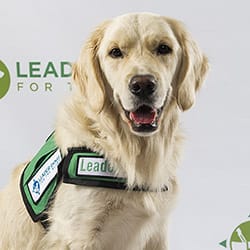 Arctic is a golden retriever born on June 19, 2017. He is hosted by a member of our marketing team. Arctic’s puppy raiser lives in Traverse City, so he’s used to Michigan snow. Fun fact: he is the only dog in recorded Leader Dog history named Arctic! Arctic often comes to work at Leader Dog and loves playing with the other ambassador dogs and pet dogs. He is especially fond of fellow Ambassador Dogs Piper and Lily. At home, Arctic loves spreading all his toys (and there are many) throughout the house so he always has something to play with or chew. His favorite toy is a stuffed hedgehog, closely followed by a mini pig, a small lamb and an almost life-sized dog. He is extremely well behaved at home and has only been known to bark twice since becoming an ambassador. Arctic is a sucker for a belly rub and will take that over a treat any day.
Arctic is a golden retriever born on June 19, 2017. He is hosted by a member of our marketing team. Arctic’s puppy raiser lives in Traverse City, so he’s used to Michigan snow. Fun fact: he is the only dog in recorded Leader Dog history named Arctic! Arctic often comes to work at Leader Dog and loves playing with the other ambassador dogs and pet dogs. He is especially fond of fellow Ambassador Dogs Piper and Lily. At home, Arctic loves spreading all his toys (and there are many) throughout the house so he always has something to play with or chew. His favorite toy is a stuffed hedgehog, closely followed by a mini pig, a small lamb and an almost life-sized dog. He is extremely well behaved at home and has only been known to bark twice since becoming an ambassador. Arctic is a sucker for a belly rub and will take that over a treat any day.
Piper
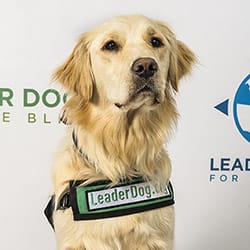 Piper is a golden retriever born on December 9, 2016. She was raised in a Michigan correctional facility. Piper is hosted by a member of Leader Dog’s information and technology team and often comes to work with her host mom when she isn’t busy with ambassador duties. When she’s working, Piper is good at her job. At home, one of her favorite things to do is play ball. When the rest of her host family runs out of energy for playing ball, she will “dribble” the ball by herself (she bounces it on the floor with her nose and then catches it)! She enjoys going for walks and loves to snuggle with her young human sister. Piper will also play “volleyball” with her by booping the ball over the ottoman with her nose. Piper is a veteran sock retriever – she doesn’t eat them, she just stacks them up on the floor, clean or dirty. Doesn’t matter to her!
Piper is a golden retriever born on December 9, 2016. She was raised in a Michigan correctional facility. Piper is hosted by a member of Leader Dog’s information and technology team and often comes to work with her host mom when she isn’t busy with ambassador duties. When she’s working, Piper is good at her job. At home, one of her favorite things to do is play ball. When the rest of her host family runs out of energy for playing ball, she will “dribble” the ball by herself (she bounces it on the floor with her nose and then catches it)! She enjoys going for walks and loves to snuggle with her young human sister. Piper will also play “volleyball” with her by booping the ball over the ottoman with her nose. Piper is a veteran sock retriever – she doesn’t eat them, she just stacks them up on the floor, clean or dirty. Doesn’t matter to her!
Cleo
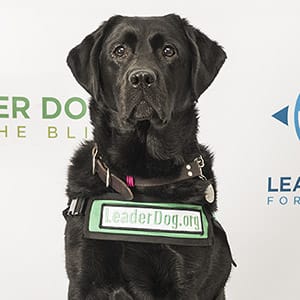 Cleo is a black Labrador and was raised in a correctional facility in Iowa. After Cleo returned to Leader Dog for training, she graduated as a Leader Dog. Unfortunately, Cleo developed tendonitis, which meant that sustained guide dog work wasn’t for her, and she returned to Leader Dog after only a few months. Cleo was adopted by one of our guide dog mobility instructors. She now lives with her family and indulges her human girl children with games and snuggles. She enjoys playing, swimming, napping and eating whenever she can. She was one of the original ambassador dogs in the program and is eager to show people what a Leader Dog can do (and accept all of the petting and praise). Cleo excels at posing for pictures and providing blindfold experiences to anyone who wants to know more about walking with a guide dog.
Cleo is a black Labrador and was raised in a correctional facility in Iowa. After Cleo returned to Leader Dog for training, she graduated as a Leader Dog. Unfortunately, Cleo developed tendonitis, which meant that sustained guide dog work wasn’t for her, and she returned to Leader Dog after only a few months. Cleo was adopted by one of our guide dog mobility instructors. She now lives with her family and indulges her human girl children with games and snuggles. She enjoys playing, swimming, napping and eating whenever she can. She was one of the original ambassador dogs in the program and is eager to show people what a Leader Dog can do (and accept all of the petting and praise). Cleo excels at posing for pictures and providing blindfold experiences to anyone who wants to know more about walking with a guide dog.
Lily
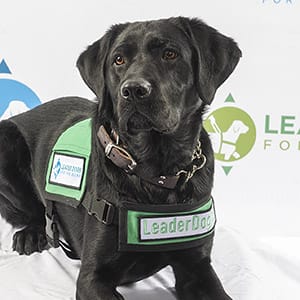 Lily was born on August 6, 2017. She is a petite black Labrador retriever and was raised in an Iowa prison. After she returned to Leader Dog for training, she was well on her way to becoming a great Leader Dog when the vet team discovered that she often got sores on her paws. Since Leader Dogs can’t have sore feet, she was career changed to be a canine ambassador. Now, Lily lives with a member of the Leader Dog philanthropy team. At home, it’s just Lily and her host mom (and Lily’s many toys). Lily’s favorite toy is a stuffed green alligator that she loves to toss in the air. Lily comes to work at Leader Dog all the time and enjoys playtime with Ambassador Dogs Coco and Arctic and office dog Laker. Even though she’s small, she is packed with energy and charisma and loves going out and meeting new people.
Lily was born on August 6, 2017. She is a petite black Labrador retriever and was raised in an Iowa prison. After she returned to Leader Dog for training, she was well on her way to becoming a great Leader Dog when the vet team discovered that she often got sores on her paws. Since Leader Dogs can’t have sore feet, she was career changed to be a canine ambassador. Now, Lily lives with a member of the Leader Dog philanthropy team. At home, it’s just Lily and her host mom (and Lily’s many toys). Lily’s favorite toy is a stuffed green alligator that she loves to toss in the air. Lily comes to work at Leader Dog all the time and enjoys playtime with Ambassador Dogs Coco and Arctic and office dog Laker. Even though she’s small, she is packed with energy and charisma and loves going out and meeting new people.
Coco
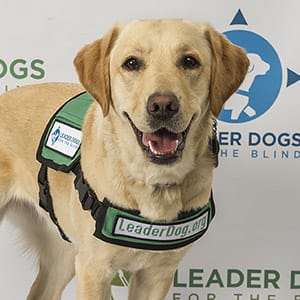 Coco is a yellow Labrador/golden retriever cross. She’s hosted by a Leader Dog team member in our philanthropy department. Her birthday is July 21, 2016. Like Cleo, she was raised in an Iowa correctional facility. Her name may be Coco, but a lot of people around Leader Dog call her “Coco Chanel.” She’s a social girl and loves playing with other dogs, which is how she spends most of her free time. Her office “pack” is Ambassador Dog Lily and office dog Laker. Coco enjoys working and she’s primarily involved with our workplace leadership training program, Harness the Power of Leadership. She’s given hundreds of blindfold walks and met a lot of people who haven’t been around dogs before. Believe it or not, Coco is the first dog a lot of people have ever petted! Her favorite part of her job is getting scratched behind the ears by new friends, and she’s an expert at posing for pictures.
Coco is a yellow Labrador/golden retriever cross. She’s hosted by a Leader Dog team member in our philanthropy department. Her birthday is July 21, 2016. Like Cleo, she was raised in an Iowa correctional facility. Her name may be Coco, but a lot of people around Leader Dog call her “Coco Chanel.” She’s a social girl and loves playing with other dogs, which is how she spends most of her free time. Her office “pack” is Ambassador Dog Lily and office dog Laker. Coco enjoys working and she’s primarily involved with our workplace leadership training program, Harness the Power of Leadership. She’s given hundreds of blindfold walks and met a lot of people who haven’t been around dogs before. Believe it or not, Coco is the first dog a lot of people have ever petted! Her favorite part of her job is getting scratched behind the ears by new friends, and she’s an expert at posing for pictures.
Flaim
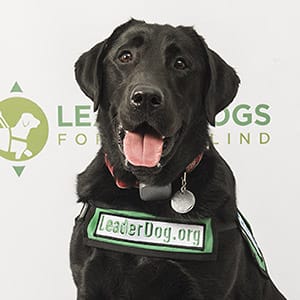 Flaim is a black Labrador born on August 20, 2016. He was raised by a volunteer puppy raiser who named him Flaim after a good friend of hers. Flaim did very well in his puppy training but unfortunately had several ear infections while in guide dog training, which led to his career change. Flaim’s host is a physician in the local area who often had patients bring their Future Leader Dog puppies to appointments. She was delighted to host Flaim as a Leader Dog ambassador. Flaim lives with his “brother” Hershey, a chocolate lab. The two bonded immediately and love playing tug of war and king of the hill in the back yard. Flaim is very sweet and affectionate, but he can also be mischievous. He once wanted a child’s toy but was told “no,” so he waited until he could stealthily make a fair trade – he put one of his toys in place of the child’s toy and added the new toy to his box!
Flaim is a black Labrador born on August 20, 2016. He was raised by a volunteer puppy raiser who named him Flaim after a good friend of hers. Flaim did very well in his puppy training but unfortunately had several ear infections while in guide dog training, which led to his career change. Flaim’s host is a physician in the local area who often had patients bring their Future Leader Dog puppies to appointments. She was delighted to host Flaim as a Leader Dog ambassador. Flaim lives with his “brother” Hershey, a chocolate lab. The two bonded immediately and love playing tug of war and king of the hill in the back yard. Flaim is very sweet and affectionate, but he can also be mischievous. He once wanted a child’s toy but was told “no,” so he waited until he could stealthily make a fair trade – he put one of his toys in place of the child’s toy and added the new toy to his box!
Drago
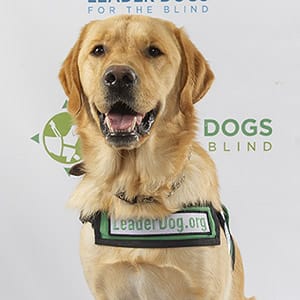 Drago is a Labrador/golden retriever cross born on February 26, 2017. He was raised in a correctional facility in Michigan. In guide dog training, Drago was sometimes more interested in things besides doing guide dog work, so his instructors decided that he’d be better as a Leader Dog ambassador. In addition to assisting with blindfold walks, Drago has also gone to school to help educate children about service animals. He enjoys his job because he LOVES meeting people! His host mom works on the Leader Dog philanthropy team, and he comes to work with her a lot. At home, Drago likes to play fetch with his host dad, play “keep away” with his toys with his terrier brother, and keep a respectful distance from his cat sister (he loves her, but she’s moody). Drago is a mellow boy, though he tends to get very excited when people come to say hello and he always grabs the closest toy to offer them.
Drago is a Labrador/golden retriever cross born on February 26, 2017. He was raised in a correctional facility in Michigan. In guide dog training, Drago was sometimes more interested in things besides doing guide dog work, so his instructors decided that he’d be better as a Leader Dog ambassador. In addition to assisting with blindfold walks, Drago has also gone to school to help educate children about service animals. He enjoys his job because he LOVES meeting people! His host mom works on the Leader Dog philanthropy team, and he comes to work with her a lot. At home, Drago likes to play fetch with his host dad, play “keep away” with his toys with his terrier brother, and keep a respectful distance from his cat sister (he loves her, but she’s moody). Drago is a mellow boy, though he tends to get very excited when people come to say hello and he always grabs the closest toy to offer them.
Ferris
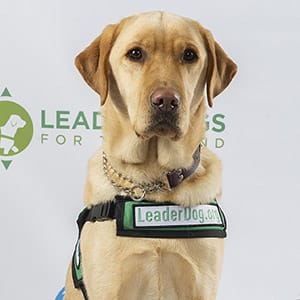 Ferris is a yellow Labrador and was born on June 13, 2017. He was also raised in a Michigan correctional facility. He’s named after the crazy but lovable Ferris Bueller of Ferris Bueller’s Day Off. At home, he loves to sneak naps on the ottoman. He has another crazy companion at home named Ranger, a golden retriever who loves to play with Ferris. The two of them race all over their yard and the house, and they frequently compete to be the cutest. Ferris loves balls but he’s also happy to try to play with whatever toy Ranger currently has. Ferris is a super friendly dog and everyone in his host family loves him. He fits right in with the family too since most of his human siblings also have Labradors. Even though Ferris loves his playtime, he has great obedience skills and sticks close to his host mom’s side whenever he can.
Ferris is a yellow Labrador and was born on June 13, 2017. He was also raised in a Michigan correctional facility. He’s named after the crazy but lovable Ferris Bueller of Ferris Bueller’s Day Off. At home, he loves to sneak naps on the ottoman. He has another crazy companion at home named Ranger, a golden retriever who loves to play with Ferris. The two of them race all over their yard and the house, and they frequently compete to be the cutest. Ferris loves balls but he’s also happy to try to play with whatever toy Ranger currently has. Ferris is a super friendly dog and everyone in his host family loves him. He fits right in with the family too since most of his human siblings also have Labradors. Even though Ferris loves his playtime, he has great obedience skills and sticks close to his host mom’s side whenever he can.
Ellie
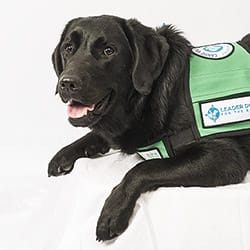 Ellie was born on June 2, 2016. Her dad was a golden retriever and her mom was a Labrador. When she’s not helping out at Leader Dog giving blindfold walks, she’s at home with her host family. Her family has two active kids who love to help Ellie get her energy out by throwing balls for her and chasing her around. Her favorite thing to do is play (either tug or fetch). Her host family also has two pet Labradors that Ellie romps around with when she isn’t busy with the kids. Ellie is a water dog and she loves to swim. Lucky for her, her family has a pool where she can doggie paddle to her heart’s content. Like Arctic, Ellie is a quiet girl who tends to express her excitement without much barking.
Ellie was born on June 2, 2016. Her dad was a golden retriever and her mom was a Labrador. When she’s not helping out at Leader Dog giving blindfold walks, she’s at home with her host family. Her family has two active kids who love to help Ellie get her energy out by throwing balls for her and chasing her around. Her favorite thing to do is play (either tug or fetch). Her host family also has two pet Labradors that Ellie romps around with when she isn’t busy with the kids. Ellie is a water dog and she loves to swim. Lucky for her, her family has a pool where she can doggie paddle to her heart’s content. Like Arctic, Ellie is a quiet girl who tends to express her excitement without much barking.
